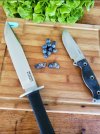- Joined
- Dec 7, 2019
- Messages
- 3,623
Although weight and space considerations should also be taken into account, it’s always prudent to have backup knives for your “societal collapse loadout.” Any knife can break, without exception, and when they do it’s usually the worst ducking time. To cite some revolutionary math, “One is none, two is one, three is even better.”You have no concept of the horrors I have "dreamed" of... but only so much is survivable at all and even less is worth surviving long term .
Even the world's best knife is still only a knife . So best save some $$$$ for other stuff you might need for your nightmare worst case survival scenarios .







